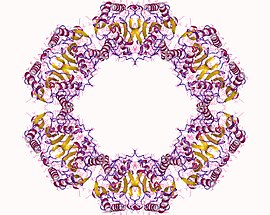| protein-serine/threonine phosphatase | |||||||||
|---|---|---|---|---|---|---|---|---|---|
 Protein serine/threonine phosphatase dodecamer, Human | |||||||||
| Identifiers | |||||||||
| EC no. | 3.1.3.16 | ||||||||
| CAS no. | 9025-75-6 | ||||||||
| Databases | |||||||||
| IntEnz | IntEnz view | ||||||||
| BRENDA | BRENDA entry | ||||||||
| ExPASy | NiceZyme view | ||||||||
| KEGG | KEGG entry | ||||||||
| MetaCyc | metabolic pathway | ||||||||
| PRIAM | profile | ||||||||
| PDB structures | RCSB PDB PDBe PDBsum | ||||||||
| |||||||||
The enzyme protein serine/threonine phosphatase (EC 3.1.3.16; systematic name protein-serine/threonine-phosphate phosphohydrolase)[1] is a form of phosphoprotein phosphatase that acts upon phosphorylated serine/threonine residues:
[a protein]-serine/threonine phosphate + H2O = [a protein]-serine/threonine + phosphate
Serine and threonine phosphates are stable under physiological conditions, so a phosphatase enzyme has to remove the phosphate to reverse the regulation signal. Ser/Thr-specific protein phosphatases are regulated partly by their location within the cell and by specific inhibitor proteins.
Serine and threonine are amino acids which have similar side-chain compositions that contain a hydroxyl group and thus can be phosphorylated by enzymes called serine/threonine protein kinases. The addition of the phosphate group can be reversed by enzymes called serine/threonine phosphatases. The addition and removal of phosphate groups regulates many cellular pathways involved in cell proliferation, programmed cell death (apoptosis), embryonic development, and cell differentiation.
Examples[edit]
There are several known groups with numerous members in each:
- PPP1 (α, β, γ1, γ2)
- PPP2 (formerly 2A)
- PPP3 (formerly 2b, also known as calcineurin)
- PPP2C
- PPP4
- PPP5
- PPP6
(links are to the catalytic subunit)
References[edit]
- ^ Shi Y (October 2009). "Serine/threonine phosphatases: mechanism through structure". Cell. 139 (3): 468–84. doi:10.1016/j.cell.2009.10.006. PMID 19879837.
External links[edit]